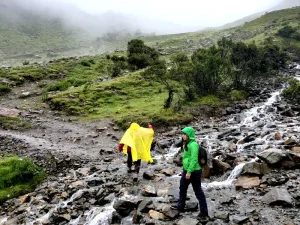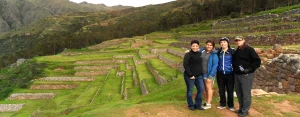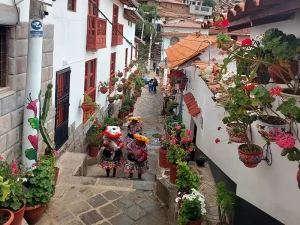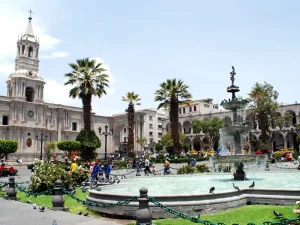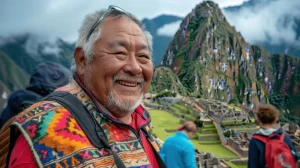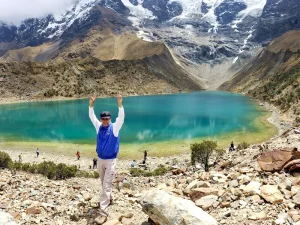I remember the first time I truly understood the magic of Peruvian food. I was six years old, standing on a wobbly stool in my abuelita’s kitchen in Lima, the air thick with the scent of ají amarillo and simmering onions. She was teaching me how to make causa limeña, her hands deftly layering the vibrant yellow potato mixture with shredded chicken and avocado. “Mijito,” she said, her voice warm and steady, “food is not just to fill the belly. It is a story. In every bite, you taste the history of our people—the Inca, the Spanish, the Africans, the Japanese, the Chinese. We are all right here, on this plate.”
That lesson has stayed with me my entire life, through my years as a tour guide sharing these stories with travelers from around the world. Peru is not just a place you visit for its ancient ruins or breathtaking landscapes; it is a culinary destination of the highest order. It’s a place where food is the central thread of culture, identity, and celebration. Come with me, and let’s explore the rich, complex, and utterly delicious world of Peruvian gastronomy.
A Taste of Peru That Stays in Your Soul
Close your eyes and imagine this: you’re sitting in a lively market in Cusco, the scent of grilled anticuchos (beef heart skewers) rising from nearby stalls, while a vendor pours you a refreshing glass of chicha morada, made from purple corn. Children laugh, music plays softly in the background, and before you is a dish that tells the story of centuries—flavors of the Incas, touches of Spain, whispers from Africa, China, and Japan, all fused into one plate.
This is what I tell travelers when they first ask me about Peruvian cuisine: Here, food is not only about eating—it’s about connecting with history, landscapes, and people. Every dish is a story, every flavor a journey. And as your Peruvian guide, let me take you through the kitchens, markets, festivals, and restaurants that make Peru one of the world’s greatest culinary destinations.
Why Peruvian Cuisine Matters: A Fusion Forged in History
Peruvian food didn’t become a global phenomenon by accident. Its rise is a direct result of its incredible diversity of ingredients and a unique history that brought cultures together in a melting pot of flavors.
Peru is one of the world’s megadiverse countries, home to 90 of the planet’s 104 microclimates. This gives us an astonishing biodiversity: over 4,000 varieties of native potatoes, more than 55 types of corn in every color imaginable, a vast array of chilies (ajíes), unique fruits like lúcuma and aguaymanto, and incredible seafood from the cold Humboldt Current.
This natural pantry was masterfully utilized by the Inca and pre-Inca cultures. Then came the Spanish conquest, which brought onions, garlic, citrus, chicken, beef, and pork. Later, waves of immigration further enriched our culinary tapestry:
- African influences from enslaved peoples gave us techniques and dishes like anticuchos (beef heart skewers).
- Chinese immigrants in the 19th century created Chifa, a beautiful fusion that gave us Lomo Saltado.
- Japanese immigrants brought their precise techniques for raw fish, which evolved into our national treasure, ceviche.
This is why Peruvian cuisine is so special. It’s a story of resilience, adaptation, and creativity—a story you can taste.
Many people know Peru for Machu Picchu, but food is another wonder travelers discover when they arrive. Here’s why it matters:
- Global Recognition: Lima has been named the World’s Leading Culinary Destination multiple times by the World Travel Awards.
- Cultural Fusion: Centuries of blending Inca traditions with Spanish, African, Asian, and European influences created a unique and diverse cuisine.
- Geographic Diversity: Coast, Andes, and Amazon—each region offers completely different ingredients and dishes.
- Authentic Experience: Tasting Peruvian food is like traveling through time and geography without leaving the table.
The Heartbeat of the Kitchen: Essential Peruvian Ingredients
To understand our food, you must first meet its stars.
- Ajíes (Chilies): The soul of Peruvian flavor. Not just about heat, they provide depth, color, and fruitiness.
- Ají Amarillo: The most important. Yellow-orange, medium heat, with a fruity flavor. Base for countless creams and sauces.
- Ají Panca: Red, smoky, and mild. Used for marinades and stews.
- Rocoto: Looks like a bell pepper but packs a serious punch. Used for spicy sauces and rocoto relleno.
- Potatoes (Papa): We are the birthplace of the potato. You’ll taste varieties you never knew existed—deep purple, bright red, earthy and nutty. They are our pride.
- Corn (Choclo): Forget the sweet corn you know. Our choclo has giant, starchy kernels and is served alongside everything, especially ceviche.
- Quinoa: The ancient “mother grain” of the Incas, a protein-packed superfood we’ve eaten for millennia.
- Aromatic Bases: Every stew starts with sofrito—a sauté of onions, garlic, and ajíes. The other essential base is huacatay, a pungent black mint that flavors the famous ocopa sauce.
History & Culture Behind Peruvian Cuisine
Peruvian food is a reflection of our cultural mosaic.
- Pre-Columbian Roots: Ancient Peruvians domesticated potatoes (over 3,000 varieties), corn, quinoa, and peppers. These became the backbone of our diet.
- Spanish Influence: After the conquest, wheat, rice, beef, pork, and dairy entered our kitchens.
- African Contributions: Slaves brought spices and creativity, giving birth to iconic dishes like anticuchos.
- Asian Influence: Chinese migrants (19th century) created chifa (Chinese-Peruvian fusion), while Japanese migrants gave us nikkei cuisine, blending sashimi and ceviche styles.
The result? A cuisine that is as multicultural as it is deeply Peruvian.
How to Get a True Taste of Peru
As your guide, I always say: Don’t limit yourself to restaurants—Peru’s soul lives in its markets and family kitchens.
- In Lima: World-class restaurants like Central and Maido take gastronomy to art form.
- In Cusco & Sacred Valley: Try hearty Andean dishes like chuño soup or trucha (trout) by the riverside.
- In the Amazon: Taste exotic fruits like camu camu and dishes wrapped in banana leaves.
- In Arequipa: Visit a picantería, where spicy stews and traditional drinks are served with love.
Best Time to Enjoy Peruvian Cuisine
Honestly, Peru is a year-round food destination. But:
- June–August (dry season in Andes): Best for markets and food festivals in Cusco.
- October: Lima celebrates Señor de los Milagros, and turrón de Doña Pepa is a seasonal treat.
- March: Ica hosts the Vendimia (wine and pisco harvest festival).
What to Taste: Peru’s Culinary Icons
Here’s a guide to the dishes you can’t miss:
1. Ceviche
- Fresh fish marinated in lime, chili, and onion.
- Best enjoyed by the coast, especially Lima.
- Tip: Always eat ceviche at lunchtime—it’s freshest then.
2. Lomo Saltado
- A wok-fried fusion of beef, onions, tomatoes, and soy sauce.
- A symbol of Chinese-Peruvian chifa cuisine.
3. Aji de Gallina
- Shredded chicken in a creamy yellow chili sauce.
- Comfort food with colonial origins.
4. Pachamanca
- Ancient Andean feast: meats and potatoes cooked underground with hot stones.
- Often prepared during festivals or family gatherings.
5. Rocoto Relleno
- Spicy pepper stuffed with meat, cheese, and egg.
- Specialty of Arequipa.
6. Amazonian Flavors
- Juane: Rice, chicken, and spices wrapped in leaves.
- Tacacho con Cecina: Plantains mashed with pork.
Comparative Table: Peru’s Regional Flavors
| Region | Signature Dish | Key Ingredients | Best Place to Try |
| Coast | Ceviche | Fish, lime, chili, onion | Lima, Trujillo |
| Andes | Pachamanca | Meats, potatoes, hot stones | Sacred Valley |
| Amazon | Juane | Rice, chicken, banana leaves | Iquitos, Tarapoto |
| Arequipa | Rocoto Relleno | Spicy pepper, meat, cheese | Arequipa |
| Fusion | Lomo Saltado | Beef, soy sauce, fries | Lima, Cusco |
The Liquid Soul of Peru: Drinks & Libations
- Pisco Sour: The national cocktail. Pisco (a grape brandy) is shaken with lime juice, simple syrup, egg white, and angostura bitters. It’s frothy, tart, sweet, and strong. Perfection.
- Chicha Morada: Not to be confused with chicha de jora (a fermented corn beer). This is a non-alcoholic beverage made from purple corn, boiled with pineapple, cinnamon, and cloves. It’s sweet, refreshing, and deep purple.
- Inca Kola: A bright yellow, bubblegum-flavored soda that is inexplicably more popular than Coca-Cola in Peru. It’s a cultural icon.
- Coca Tea: Not a party drink! This herbal tea made from coca leaves is essential for helping visitors acclimatize to the high altitude in Cusco and the Andes.
Festivals & Gastronomy
Food and festivals in Peru go hand in hand. During celebrations, traditional dishes appear everywhere:
- Inti Raymi (Cusco, June): Eat chiriuchu, a cold dish with guinea pig, chicken, cheese, and corn.
- Señor de los Milagros (Lima, October): Streets filled with turrón de Doña Pepa, a sweet with honey and sprinkles.
- Carnaval (Cajamarca, February): Dances, water fights, and hearty stews.
- National Ceviche Day (June 28): Celebrated across the coast with seafood festivals.
Travel Tips: Eating Safely & Smartly in Peru
- Street Food: Delicious, but choose busy stalls where locals eat.
- Altitude Eating: In the Andes, eat light on your first day to help acclimatize.
- What to Bring: Always carry bottled water and maybe a small bottle of hand sanitizer.
- Vegetarian Options: Increasingly available—try quinoa dishes, tamales, or veggie ceviche.
Comparison with Other Culinary Destinations
Some travelers ask me, “How does Peru compare to Italy or Japan for food?” My answer: Peru is unique because it combines ancient roots with multicultural fusion. Unlike France or Japan, where techniques dominate, Peru thrives on creativity, diversity, and storytelling through food.
That’s why chefs from all over the world come to Peru—to learn, to taste, and to be inspired.
Peruvian Food FAQs: Your Questions, Answered
Is Peruvian food spicy?
It can be, but it’s not inherently fiery. The spice often comes from sauces (salsas) served on the side, like ají verde (green sauce). You can control the heat level. Dishes like Aji de Gallina are only mildly spicy.
Is it safe to eat street food in Peru?
Generally, yes, but use common sense. Follow the locals! Eat at stalls that are busy, where the food is cooked fresh in front of you, and where the general hygiene appears good. Avoid uncooked vegetables that may have been washed in tap water.
What is a typical breakfast in Peru?
It’s often simple: bread with butter, jam, or avocado, accompanied by coffee or tea. A more hearty option is tamales or humitas (savory corn cakes). In hotels, you’ll find a more international spread.
I’m a vegetarian/vegan. Is Peru a good destination for me?
Absolutely! While many famous dishes are meat-based, there are incredible vegetarian options. Causa Limeña (without chicken), Papa a la Huancaína, Lentejas (lentil stew), Quinoa soups, and Chifa vegetable stir-fries are all widely available. Lima and Cusco have many dedicated vegan restaurants.
What is the number one tip for food lovers visiting Peru?
Be adventurous. Say yes to things that sound unfamiliar. That might mean trying cuy, a new fruit at the market, or a street food skewer. The greatest culinary discoveries happen when you step outside your comfort zone.
Conclusion: More Than a Meal, It’s a Memory
Peruvian cuisine is a journey. It’s a journey through history, across breathtaking landscapes, and into the homes and hearts of the Peruvian people. It’s the taste of a perfect ceviche on a sunny Lima afternoon, the warmth of a shared Pachamanca in the Sacred Valley, the invigorating kick of a Pisco Sour as the sun sets over the Andes.
This culinary adventure is waiting for you. Don’t just read about it—come and taste it.Ready to embark on the ultimate food journey? As a local guide, I always recommend traveling with a knowledgeable, Peruvian-based tour operator who can take you beyond the tourist menus. They can arrange cooking classes with local chefs, guide you through bustling markets, and secure reservations at the best picanterías for a true taste of authentic Peru. Let us guide you to the soul of our country, one unforgettable bite at a time.

